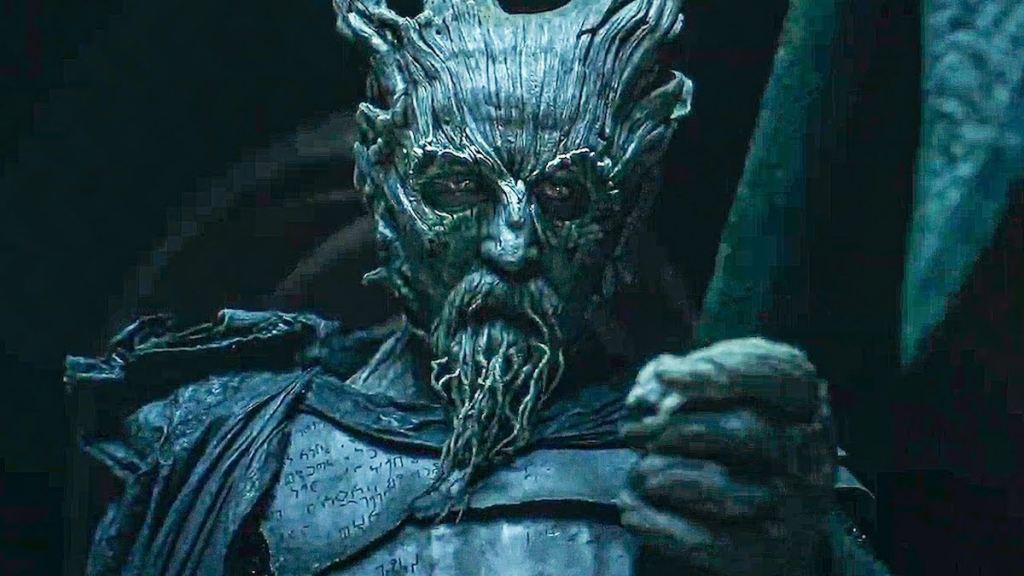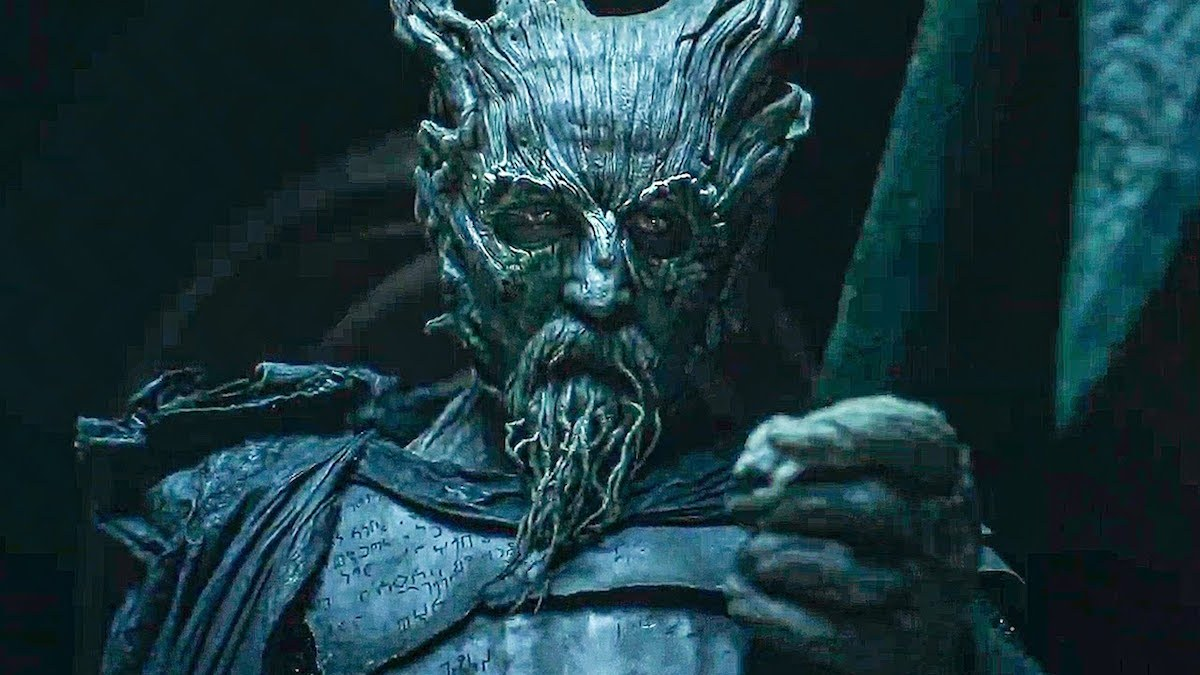If you enjoy reading Electric Literature, join our mailing list! We’ll send you the best of EL each week, and you’ll be the first to know about upcoming submissions periods and virtual events.
When David Lowery and A24’s The Green Knight hit theaters this Friday, I, a medievalist scholar, was giddy with delight. The film is absolutely stunning, and it’s based on one of my favorite books: the 14th-century English poem Sir Gawain and the Green Knight. The plot of both the poem and the film begins when a mysterious figure, the Green Knight, bursts into King Arthur’s hall and demands that someone strike him with an axe. What can I say: medieval literature is weird.
Sir Gawain, Arthur’s nephew, bravely steps up to the plate, giving him a good whack on the neck. But after he’s beheaded, the Green Knight picks up his own severed head like nothing has happened and tells Gawain to meet him for a fight on Christmas of the next year. What follows is an extraordinary journey across the Welsh wilderness, as Gawain, the poem’s protagonist, chases down the mysterious knight to fulfill his end of a bargain. The film’s visuals are stunning, featuring moody court scenes and sweeping panoramas of the English landscape. And with the wildly talented and unbelievably handsome Dev Patel playing Gawain? For medieval nerds like yours truly, July 30th was like Christmas.
The thing is, in the original Middle English, the Green Knight is unambiguously hot.
Like most great adaptations, Lowery’s The Green Knight takes plenty of liberties to remake an old story for modern viewers, revising plot, themes. Characters’ roles change: Guinevere fades into the film’s background, while Arthur becomes a more prominent father figure. Certain textual nuances, like the poem’s emphasis on clothing and decorative detail, are lost or simplified. Meanwhile, Lowery adds new subplots, like the haunting tale of Saint Winifred. That’s all well and good, and makes for a delightful twist on the original. As a scholar and lover of the poem, however, I do nonetheless have my personal bone to pick: in the film, the Green Knight character is Not Hot. And, according to the original poem, he should be. Very.
Now, calling the film’s Green Knight is homely is no knock to the ruggedly handsome Ralph Ineson, who plays him under so much CGI and prosthetics and makeup that his real face is hardly visible. Instead, we get the clear sense that, in keeping with the film’s dark, supernatural aesthetic, the film’s producers chose to make the Green Knight monstrous rather than babe-material. His bark-covered face is spooky rather than suave.

The thing is, in the original Middle English, the Green Knight is unambiguously hot. We’re first introduced to him at the beginning of the poem, when the Green Knight crashes Arthur’s Christmas party. The narrative gaze dwells on the Green Knight’s huge, muscular body, on his square and thick neck and abs (“swyre” and “swange”) and big long sides and limbs (“lyndes” and “lymes”). He is the biggest smokeshow of his size (“the myriest in his muckel that myght ride”)! His luscious hair is splayed out over his shoulders (“fayre fannand fax umbefoldes his schulderes”)! He’s riding a freaking horse! But there’s something delicate about his good looks as well—he has a slim waist and a taut stomach that is visible through his tight, fur-trimmed, embroidered coat (“both his wombe and his wast were worthily smale”). On and on the description continues, for almost a hundred lines. Sure, he’s head-to-toe emerald green (“overal ener-grene”), but the text doesn’t mince words—in spite of his otherworldly complexion, the Green Knight is a sexy, sexy man.
The Green Knight’s hotness matters, because it shapes how we understand the poem’s emphasis on and relationship to desire.
Call me thirsty, but the Green Knight’s hotness matters, because it shapes how we understand the poem’s emphasis on and relationship to desire, and to queer desire in particular. When I teach Sir Gawain and the Green Knight to undergraduates, my students are surprised to find it “steamy.” Sir Gawain and the Green Knight is often read, in fact, among queer and feminist medievalist scholars as a text that flirts with sexual transgression. When the poem carefully, intimately catalogues the Green Knight’s good looks just as it does the beauty of its female characters, it gives the reader permission to focus their erotic gaze broadly. This is a text, the poem tells us, where gender doesn’t determine who is worthy of a backwards glance.
In the film, on the other hand, Lowery and Patel construct a distinctly heterosexual Gawain. We meet him in a brothel with a woman in the first scene of the film. Throughout, Gawain’s relationships with women are front and center: he has a female lover in Camelot who does not exist in the original poem, and an adulterous affair with a mysterious seductress he meets on his journeys. Long closeups of the film’s beautiful ladies in soft lighting take the place of the poem’s admiring gaze at the Green Knight.

Yes, the film’s Gawain does receive one kiss from a lord of a castle—but he receives the kiss, and without much build up, the moment feels somewhat out of the blue. The film doesn’t really prepare us for the smooch, which ends when Gawain, as surprised as the audience, breaks away and flees the scene. In the poem, meanwhile, Gawain kisses a lord three times, and it’s Gawain, not the lord, who initiates the romance, which has higher stakes than just a chaste peck. To explain: as in the film, the lord of the poem goes out hunting each of the three days he hosts Gawain, and agrees to exchange his daily winnings with Gawain’s back at the castle each night. Gawain’s prizes, however, are somewhat scandalous: each day, the lady of the castle seduces and kisses Gawain. Gawain, quick to uphold his end of the bargain, kisses Lord Bertilak every day when he returns. As scholars like Carolyn Dinshaw have pointed out, it’s implied that if Gawain were to sleep with the lady, he would need to sleep with the lord too, according to the rules of the game.
The poem invites us to see more broadly, while the film’s intervention takes a primarily heterosexual point of view
In the poem’s universe, it’s later revealed that the Green Knight and this lord—who are distinct characters in the film—are actually the same person in disguise. It also comes to light that the lady conspired with the disguised Green Knight to seduce Gawain, in what is basically an attempt at medieval swinging. So, this major plot twist of the poem, which does not come about in the film, hinges on the possibility of polyamorous relationships and queer intimacy between Gawain and the Green Knight, disguised as the lord. With this subplot, and all the preparation leading up to it, the poem invites us to see more broadly, while the film’s intervention takes a primarily heterosexual point of view.
With this in mind, as much as I enjoyed the film, I’m sad to lose the Green Knight’s sexiness. All adaption, of course, deviates from the original text, and that is well and good. Lowery’s The Green Knight offers us new ways of seeing the story, bringing into focus the pressures of masculinity and the relationship between humans and nature. But it also reiterates a vision of the Middle Ages that is primarily heterosexual—a vision that tells us more about how we think about the past than about how that past actually was. The original poem points us instead to the long history of queer desire, celebrating and playing with the complexity of eroticism and intimacy. The film’s de-sexified Green Knight, meanwhile, downplays the story’s queer possibilities. So much as I enjoyed the film, I invite you also to drool over the original—where the poem’s smoldering glance at the very handsome Green Knight may matter more than Lowery’s version gives it credit for.
Quotes from Sir Gawain and the Green Knight are from an edition by J.J. Anderson.
